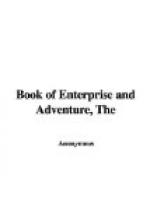Two Biparies[1] were driving a string of loaded bullocks to Chittrah from Palamow. When they were come within a few miles of the former place, a tiger seized on the man in the rear, which was seen by a Guallah [herdsman], as he was watching his buffaloes grazing. He boldly ran to the man’s assistance, and cut the tiger severely with his sword; upon which he dropped the Biparie and seized the herdsman: the buffaloes observing it, attacked the tiger, and rescued the poor man; they tossed him about from one to the other, and, to the best of my recollection, killed him; but of that I am not quite positive. Both of the wounded men were brought to me. The Biparie recovered, and the herdsman died.
[Footnote 1: Bipar signifies merchandise, and Biparies are people who buy grain, and other articles, which they transport from one part of the country to another on bullocks.]
An elderly man and his wife (of the lowest caste of Hindoos, called dooms, who live chiefly by making mats and baskets) were each carrying home a bundle of wood, and as they were resting their burdens on the ground, the old man hearing a strange noise, looked about, and saw a tiger running off with his wife in his mouth. He ran after them, and struck the tiger on the back with a small axe: the tiger dropt the wife, who was soon after brought to me. One of her breasts was almost entirely taken away, and the other much lacerated: she had also several deep wounds in the back of her neck, by which I imagine the tiger struck at her with his two fore paws; one on the neck, and the other on the breast. This, if I may judge from the number I have seen wounded, is their usual way of attacking men. The old woman was six months under my care, and at last recovered.
As an old Mahometan priest was travelling at mid-day on horseback, within a few miles of Chittrah, with his son, an athletic young man, walking by his side, they heard a tiger roaring near them. The son urged his father to hasten on; the old man continued at a slow pace, observing that there was no danger, the tiger would not molest them. He then began counting his beads, and offering his prayers to the Almighty; in the act of which he was knocked off his horse, and carried away by the tiger; the son ran after them, and cut the tiger with his sword; he dropped the father, seized the son, and carried him off. The father was brought to Chittrah, and died the same day; the son was never heard of afterwards. In this instance, I think, the tiger must have been ravenously hungry, or he would not have roared when near his prey; it is what they seldom or ever do, except in the very act of seizing....
Some idea may be formed how numerous the tigers must have been at one period in Bengal, from the circumstance, that one gentleman is reported to have killed upwards of three hundred and sixty.




